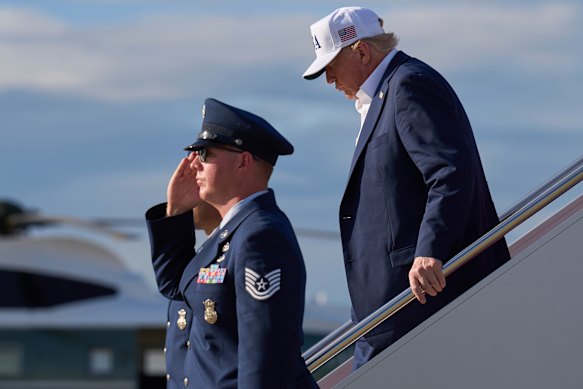- Updated
- World
- North America
- Trade wars
Trump triggers fresh trade angst as he unveils raft of new tariffs
By Jeff Mason, Bart H. Meijer and David Brunnstrom
Washington: President Donald Trump began telling trade partners – from powerhouse suppliers like Japan and South Korea to minor players – that sharply higher US tariffs will start August 1, marking a new phase in the trade war he launched earlier this year.
The 14 countries sent letters so far, which included smaller US exporters such as Serbia, Thailand and Tunisia, hinted at opportunities for additional negotiations while at the same time warning that any reprisal steps would be met with a like-for-like response.

President Donald Trump leaving Air Force One on Sunday.Credit: AP
“If for any reason you decide to raise your Tariffs, then, whatever the number you choose to raise them by, will be added onto the 25 per cent that we charge,” Trump said in letters to Japan and South Korea, released on his Truth Social platform on Monday, Washington time.
The letters were not the final word from Trump on tariffs, so much as another episode in a global economic drama in which the US president has placed himself at the centre.
The higher tariffs will, notably, not combine with previously announced sector tariffs such as those on automobiles and steel and aluminum.
That means, for instance, that Japanese vehicle tariffs will remain at 25 per cent, rather than the existing 25 per cent sector tariff climbing to 50 per cent with the new reciprocal rate as has occurred with some of Trump’s tariffs.
The clock has been ticking for countries to conclude deals with the US after Trump in April unleashed a global trade war that has roiled financial markets and sent policymakers scrambling to protect their economies.
Trading partners got another reprieve as the White House said Trump will sign an executive order on Monday extending the Wednesday deadline for negotiations to August 1.
Asked if the deadline was firm, Trump said: “I would say firm, but not 100 per cent firm. If they call up and they say we’d like to do something a different way, we’re going to be open to that.”
Trump has kept much of the world guessing on the outcome of months of talks with countries hoping to avoid the hefty tariff hikes he has threatened.
The rate for South Korea is the same as Trump initially announced, while the rate for Japan is 1 point higher than first announced on April 2. A week later, he capped all of the tariffs at 10 per cent until Wednesday. Only two agreements have so far been reached, with Britain and Vietnam.
Wendy Cutler, vice president of the Asia Society Policy Institute, said it was unfortunate that Trump was hiking tariffs for two of the closest US allies, but there was still time for a breakthrough in negotiations.
“While the news is disappointing, it does not mean the game is over,” Cutler said.
Trump said later Monday that the United States would impose 25 per cent tariffs on Tunisia, Malaysia and Kazakhstan; 30 per cent on South Africa, Bosnia and Herzegovina; 35 per cent on Serbia and Bangladesh; 36 per cent on Cambodia and Thailand and 40 per cent on Laos and Myanmar.
South Korea’s Industry Ministry said in a statement that the letter effectively extended a grace period on the implementation of tariffs by the US and that it would intensify trade talks.
“We will step up negotiations during the remaining period to reach a mutually beneficial result to quickly resolve the uncertainties from tariffs,” it said.
There was no immediate response from the Japanese embassy.
US stocks fell in response, the latest market turmoil as Trump’s trade moves have repeatedly whipsawed financial markets and sent policymakers scrambling to protect their economies.
The European Union, meanwhile, will not be receiving a letter setting out higher tariffs, EU sources familiar with the matter told Reuters.
The European Union still aims to reach a trade deal by July 9 after European Commission President Ursula von der Leyen and Trump had a “good exchange,” a commission spokesperson said. It was not clear, however, whether there had been a meaningful breakthrough in talks to stave off tariff hikes on the United States’ largest trading partner.
The EU has been torn over whether to push for a quick and light trade deal or leverage its economic clout to negotiate a better outcome. It had already given up hopes for a comprehensive trade agreement before the July deadline.
Trump has also said he could impose a 17 per cent tariff on EU food and agriculture exports. The president also threatened leaders of developing nations in the BRICS group, who are meeting in Brazil, with an additional 10% tariff if they adopt “anti-American” policies.
The group includes Brazil, Russia, India and China among others.
Reuters, AP
Get a note directly from our foreign correspondents on what’s making headlines around the world. Sign up for our weekly What in the World newsletter.